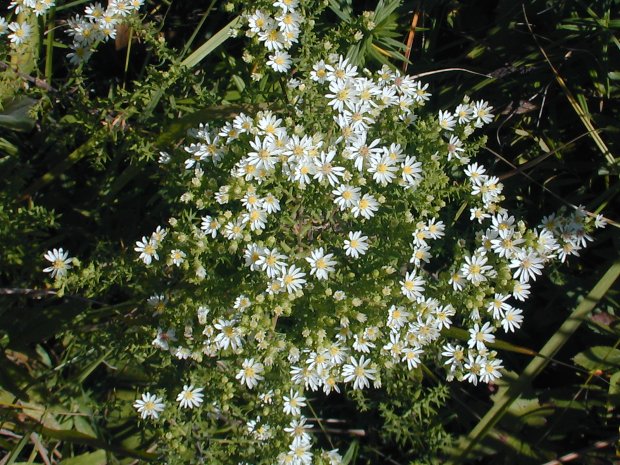Description: This herbaceous perennial plant is up to 2' tall, branching occasionally to create a bushy appearance. The hairy stems are green initially, but often become brown when the plant matures. The alternate leaves are up to 3" long and ¼" across toward the base of the plant, becoming less than 1" long and 1/8" (3 mm.) across near the flowering stems. They are linear in form and have smooth edges, often with a fine pubescence. The lower leaves usually shrivel and fall off by the time the compound flowers bloom during the fall. These flowers are very numerous and have a daisy-like appearance. Each compound flower is a little less than ½" across, and consists of numerous yellow disk florets, which are surrounded by about 12 white ray florets. There is no noticeable floral scent. There are numerous needle-like green bracts on the flowering stems, giving this plant a heath-like appearance. The little seeds have tufts of white hairs, and are distributed by the wind. The root system is rhizomatous.

Cultivation:
The
preference is full sun and average to dry conditions. The soil can
contain significant amounts of loam, clay, or gravelly material;
alkaline soil is tolerated. This plant withstands drought. It often
spreads vegetatively to form colonies, especially in open disturbed
areas.
Range & Habitat:
The native Heath Aster is found in most counties of Illinois, but it is
absent
from some counties in the western and SE areas of the state (see Distribution
Map). Overall, it is occasional to locally common. Habitats
include mesic to dry black soil prairies, gravel prairies, dolomite
prairies, hill prairies, savannas, openings in dry rocky forests,
limestone glades, areas along roadsides and railroads, and pastures. It
can be found in both high quality habitats and disturbed areas.
Faunal Associations:
A wide variety of insects are attracted to the flowers, including
long-tongued bees, short-tongued bees, wasps, flies, butterflies,
skippers, moths, beetles, and plant bugs. Bee visitors include
honeybees, bumblebees, cuckoo bees, little carpenter bees, leaf-cutting
bees, Halictid bees, plasterer bees, and Andrenid bees. Wasp visitors
include thread-waisted wasps, bee wolves, spider wasps, sand wasps,
paper wasps, Ichneumonid wasps, and Braconid wasps. Among the flies,
are such visitors as bee flies, Syrphid flies, thick-headed flies,
Tachinid flies, Muscid flies, and others. Various insects suck juices
from the plant, including aphids, lace bugs, and plant bugs. The
caterpillars of the butterflies Chlosyne nycteis
(Silvery Checkerspot) and Phyciodes tharos (Pearl Crescent) feed on the foliage or flowers, as do the
caterpillars of many moth species (see
Moth Table).
Wild Turkeys nibble on the seeds and foliage to a limited extent.
Mammalian herbivores, including the White-Tailed Deer, Cottontail
Rabbit, and various kinds of livestock, also feed on the tender growth
of young plants occasionally, but are less likely to bother mature
plants later in the year.

Photographic
Location:
The photographs were taken at Loda Cemetery Prairie in Iroquois County,
Illinois.
Comments:
The Heath Aster has a wide distribution, and there is some variability
in regards to its size and appearance across different locations.
Sometimes it will hybridize with other species of asters, such as Symphyotrichum
novae-angliae. The Heath Aster
differs from other asters with small white flowerheads primarily by its
short, narrow leaves (never more than 3" long and ¼" across). Also, its
flowerheads tend to be smaller in size and they have fewer ray florets
(about
12) than many other aster species. A scientific synonym of this plant
is Aster ericoides.